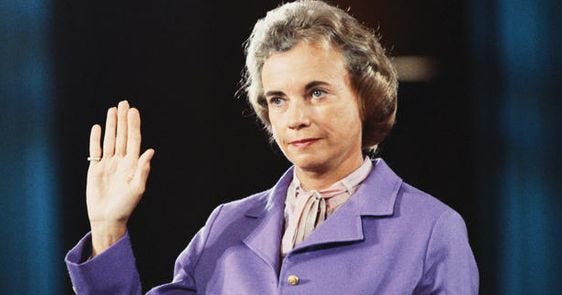remembering the Supreme Court's first woman
Sandra Day O’Connor passed away on Dec. 1 after a battle with dementia. She was 93.
Sandra Day O’Connor graduated close to the top of her class in Stanford Law in 1952. Yet, she was only offered a secretary position when she applied to a major law firm.
Ronald Reagan nominated her as a Supreme Court justice in 1981 after making campaign headlines in 1980 with his promises to elect a woman to the Supreme Court. The idea was met with hysteria. A conservative female justice was something for cinema, literally, since Broadway’s “First Monday In October” comedy that was about the exact same thing that premiered two years prior. She was well aware of the attention, as well as the stakes — the future of women in court was heavy on her shoulders.
“It’s alright to be the first to do something,” O’Connor said. “I didn’t want to be the last woman on the Supreme Court. If I took the job and did a lousy job, it would take a long time to get another one.”
O’Connor was a force to be reckoned with on the floor. She fired question after question to the lawyers. She was constantly drawing from her own and her fellow justices’ experiences, and made her decisions based on real life consequences. Throughout her time on the court, she repeatedly refused to overturn Roe v Wade despite being a Republican nominee. Her conservative ideals were relatively modern, resulting in an overall liberal outlook. She was repeatedly referred to as the most powerful woman in America.
Her support on polarizing issues came down to the wire many times, and often was the swing vote in issues regarding affirmative action, religion, abortion and voting rights. This resulted in the law becoming “basically what Sandra Day O’Connor thought it should be,” according to the New York Times. Yet, her opinion was ever evolving — O’Connor wrote key decisions to limit the use of affirmative action but in 2003 wrote that colleges and universities were justified to use race as a factor in admissions.
“Such diversity promotes learning and better prepares students for an increasingly heterogeneous workforce, for responsible citizenship and for the legal profession,” O’Connor said. Her decisions followed no path except her own — O’Connor decided each case in a methodical way with no regards to party line or majority decisions.
O’Connor was also a key justice when deliberating the president’s power to detain enemy combatants in Guantanamo Bay, declaring that the president doesn’t have absolute power to indefinitely detain American citizens without charge even in wartime. She believed the citizens had a right to a chance of rebuttal for the government’s allegations of wrongdoing.
The moderate stance on abortion is perhaps what O’Connor did best, as she prevented the overturning of Roe v Wade in 1987 yet also allowed more state restrictions on abortion. Her undue burden test — if the purpose of the state restriction has place a substantial obstacle on the abortion of a non-viable fetus, according to Cornell Law — was a core holding of Roe.
“Some of us as individuals find abortion offensive to our most basic principles of morality, but that can’t control our decision,” O’Connor said in 1992 during the decision of Planned Parenthood v. Casey. “Our obligation is to define the liberty of all, not to mandate our own moral code.”
Sandra Day O’Connor will always be remembered as the first female Supreme Court Justice. Even during her time with breast cancer, she never missed a day in court. A self-proclaimed Cowgirl, holder of the Presidential Medal of Freedom and forever an inspiration to girls aspiring to break barriers — O’Connor’s legacy is crucial in the eyes of the Supreme Court.
I don’t know if she was a good or bad person in the grand scheme of things. All I know is that it’s pretty damn cool to see a woman up there.





